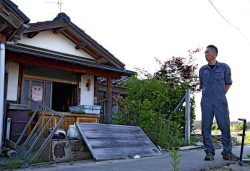Bathing Still Not Possible at Some Homes in Suzu due to Slow Repairs Six Months after Noto Peninsula Earthquake

Self-Defense Forces personnel prepare a bathing facility in Suzu, Ishikawa Prefecture, on June 14.
6:00 JST, June 22, 2024
SUZU, Ishikawa — Bathing at home is still impossible in some parts of quake-hit Suzu, Ishikawa Prefecture, nearly six months after the Jan. 1 Noto Peninsula Earthquake as repairs to septic tanks for treating sewage and sewer systems have not progressed as hoped.
The situation is an example of the difficulties in restoring infrastructure in depopulated areas.
“It’s getting hotter, and we can’t live without the help of the Self-Defense Forces,” said a 41-year-old local company employee on a recent evening after leaving a temporary bath facility set up by the Ground Self-Defense Force at the municipal Horyu Elementary and Junior High School.
The man lives in the city with his wife, children, parents and grandmother. After the quake struck, tsunami surged into the road in front of his house, which was later declared partially damaged. He and his family evacuated to Kanazawa, but returned to Suzu in May so his children could resume their studies at local junior and senior high schools.
The tap water supply to his house has been restored. However, the septic tank remains unrepaired, so the family is still waiting for workers to fix it. As used water cannot be drained, taking a bath at home is not possible. The family also has to use an emergency portable toilet.
The SDF continues to provide bathing services at the school and three other locations in Suzu, and about 500 people use them each day.
Just after the earthquake struck, the SDF set up temporary bathing facilities at 18 locations in six municipalities in the prefecture. Now, the facilities are only in Suzu, as the water and sewer systems have been restored in the other municipalities.
Before the earthquake, only about 50% of the households in Suzu were connected to the sewer system, and many used septic tanks. Since the quake struck, the repair of broken septic tanks has not progressed as hoped. Even when the water and sewer systems have been restored up to points close to households, the restoration of the water and sewer pipes extending from the systems to their premises has sometimes been similarly slow.
As each household needs to individually request repairs, the municipal government does not know how many households have yet to regain water supply and drainage capabilities.
One reason behind this situation is a serious shortage of repair workers.
Local plumbing company Sanbyakugari Kanko has 18 employees and is currently getting extra workers from other firms outside Suzu. Even so, Sanbyakugari Kanko is facing a shortage of staff to handle the many requests for repairs it has received. It is only recently that the company has been able to begin repairs for which it received orders around February.
“It’s necessary to create an environment to accept repair workers from outside the city for a long period of time,” said Nobue Kunizaki, head of the Risk & Crisis Management Educational Institute in Yokohama, which has expertise in disaster relief.
Located at the tip of the Noto Peninsula, Suzu is far not only from Kanazawa but also from Nanao and Wajima, the other cities on the peninsula. To accommodate such workers, “lodging facilities in Suzu should be quickly restored,” Kunizaki said.
To address the problem, the prefectural government submitted a proposal at a prefectural assembly meeting in June for a program to subsidize transportation and accommodations costs incurred by residents in the six municipalities to hire repair workers from outside their municipality. The project is aimed at reducing the financial burden on residents and repair workers, thus speeding up the restoration process.
A total of 168 applications had been submitted for the subsidy program by the end of May.
“It’s still difficult for local repair workers alone to handle all the needs [in the six municipalities],” a prefectural government official said.
Prolonged SDF deployment
The SDF has continued disaster relief operations in areas hit by the Noto Peninsula Earthquake for more than 170 days now, which is the second-longest quake-related deployment following the 291 days due to the 2011 Great East Japan Earthquake.
The SDF began its activities immediately after the Jan. 1 quake in response to a request from the Ishikawa prefectural government. On the following day, about 10,000 personnel from the Ground, Maritime and Air self-defense forces started relief operations. So far, they have rescued about 1,000 people and provided about 260,000 rations of food and 6,400 tons of water.
As infrastructure has been restored in various parts of the hardest-hit areas, relief efforts have been handed over to the private sector and volunteer groups. Even so, the SDF is still running temporary bathing facilities as the last service in its Noto Peninsula Earthquake operations.
“We will continue our activities as long as they are needed,” an SDF officer said.
"Society" POPULAR ARTICLE
-

M4.9 Earthquake Hits Tokyo, Neighboring Prefectures
-

M7.5 Earthquake Hits Northern Japan; Tsunami Waves Observed in Hokkaido, Aomori and Iwate Prefectures
-

Tsukiji Market Urges Tourists to Avoid Visiting in Year-End
-

Israeli Tourists Refused Accommodation at Hotel in Japan’s Nagano Pref., Prompting Protest by Israeli Embassy and Probe by Prefecture
-

M5.7 Earthquake Hits Japan’s Kumamoto Pref., Measuring Upper 5 Intensity, No Tsunami Expected
JN ACCESS RANKING
-

Keidanren Chairman Yoshinobu Tsutsui Visits Kashiwazaki-Kariwa Nuclear Power Plant; Inspects New Emergency Safety System
-

Imports of Rare Earths from China Facing Delays, May Be Caused by Deterioration of Japan-China Relations
-

University of Tokyo Professor Discusses Japanese Economic Security in Interview Ahead of Forum
-

Japan Pulls out of Vietnam Nuclear Project, Complicating Hanoi’s Power Plans
-

Govt Aims to Expand NISA Program Lineup, Abolish Age Restriction























